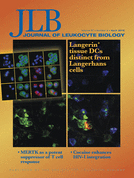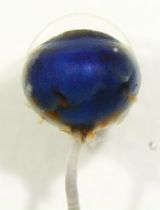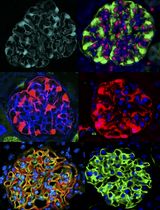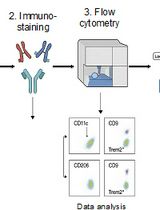- EN - English
- CN - 中文
Mouse Embryonic Fibroblast Cell Culture and Stimulation
小鼠胚胎成纤维细胞的培养和免疫刺激
发布: 2016年07月05日第6卷第13期 DOI: 10.21769/BioProtoc.1859 浏览次数: 21743
评审: Ivan ZanoniAnonymous reviewer(s)
Abstract
Culture of mouse embryonic fibroblast (MEF) cells represents a powerful system to test gene function due to their easy accessibility, rapid growth rates, and the possibility of a large number of experiments. Fibroblasts are a group of heterogeneous resident cells of mesenchymal origin that have various locations, diverse appearances and distinctive activities. Because of their ubiquitous distribution as tissue cells, these cells are poised to respond to factors released by newly activated innate immune cells, thus becoming a useful tool to study inflammation and immunity. Here, we describe procedures for mouse embryonic fibroblast cell isolation, primary culture, and stimulation. Specifically, we have optimized a step of serum starvation prior to stimulation. This step is necessary to maintain the quiescent status of these cells before they are exposed to pro-inflammatory stimuli for optimal responses. As shown in our previous studies, these mouse fibroblasts do not express Tnf, Csf2 or Il2 mRNAs at levels readily detectable by routine northern blotting techniques (Lai WS et al., 2006).
Background
Materials and Reagents
- 60-mm sterile petri dish (e.g., BD Biosciences, Falcon®, catalog number: 353002 )
Note: Currently, it is “Corning, Falcon®, catalog number: 353002”. - 100-mm sterile petri dish (e.g., Corning, catalog number: 430167 )
Note: Currently, it is “Corning, Falcon®, catalog number: 430167”. - 50 ml sterile conical tube (e.g., BD Biosciences, Falcon®, catalog number: 352070 )
Note: Currently, it is “Corning, Falcon®, catalog number: 352070”. - 5 ml sterile serological pipettes (e.g., Corning Costar®, catalog number: 4051 )
- Mice (Male and female, ideally at 8-12 weeks of age)
- Ice
- Recombinant mouse tumor necrosis factor (TNF) (R&D Systems, catalog number: 410-MT )
- 1x Phosphate-buffered saline (PBS) without calcium and magnesium
- 70% ethanol
- 0.25% trypsin/EDTA (Thermo Fisher Scientific, GibcoTM, catalog number: 25200-056 )
- 0.05% trypsin/EDTA (Thermo Fisher Scientific, GibcoTM, catalog number: 25300 )
- Fetal bovine serum defined (FBS) (GE Healthcare, HyClone, catalog number: SH30070.03 )
- Dulbecco’s modified Eagle medium (DMEM) (Thermo Fisher Scientific, GibcoTM, catalog number: 11965-092 )
- Penicillin-Streptomycin 10,000 U/ml (Thermo Fisher Scientific, GibcoTM, catalog number: 15140-122 )
- L-glutamine 200 mM (Thermo Fisher Scientific, GibcoTM, catalog number: 25030-081 )
- Rinsing medium (see Recipes)
- Complete medium (see Recipes)
- Serum-starving medium (see Recipes)
Equipment
- Dissecting microscope (e.g., Leica Microsystems, model: MZ6 )
- Dissecting instruments: tweezers and scissors
- NuAire Biological Safety Cabinet, class II, or similar
- 37 °C, 5% CO2 forced-air incubator (e.g., Thermo Fisher Scientific, FormaTM, model: 3110 )
- Centrifuge with swinging-bucket rotor and adaptors for 50-ml conical tubes
- CO2 chamber for mouse euthanization
- 37 °C shaker water bath (e.g., Thermo Fisher Scientific, PrecisionTM, model: Shaker Bath 25 )
- Autoclaved razor blades
Procedure
文章信息
版权信息
© 2016 The Authors; exclusive licensee Bio-protocol LLC.
如何引用
Qiu, L. Q., Lai, W. S., Stumpo, D. J. and Blackshear, P. J. (2016). Mouse Embryonic Fibroblast Cell Culture and Stimulation. Bio-protocol 6(13): e1859. DOI: 10.21769/BioProtoc.1859.
分类
免疫学 > 免疫细胞分离 > 维持和分化
细胞生物学 > 细胞分离和培养 > 细胞分离
您对这篇实验方法有问题吗?
在此处发布您的问题,我们将邀请本文作者来回答。同时,我们会将您的问题发布到Bio-protocol Exchange,以便寻求社区成员的帮助。
提问指南
+ 问题描述
写下详细的问题描述,包括所有有助于他人回答您问题的信息(例如实验过程、条件和相关图像等)。
Share
Bluesky
X
Copy link












